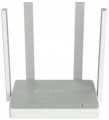Add to comparison |  |  |
|---|---|---|
| Keenetic Speedster KN-3010 | Keenetic Air KN-1611 | |
| Outdated Product | Outdated Product | |
| TOP sellers | ||
| Main | Proprietary KeeneticOS firmware with a modular interface, a bunch of settings and full localization. Beamforming and MU-MIMO. Full-fledged work with Mesh networks. | The main difference from the KN-1610 model is an increased number of LAN ports up to 4 and an increased amount of RAM from 64 to 128 MB and support for MU-MIMO. |
| Product type | router | router |
| Data input (WAN-port) | Ethernet (RJ45) Wi-Fi | Ethernet (RJ45) Wi-Fi |
Wireless Wi-Fi connection | ||
| Wi-Fi standards | Wi-Fi 3 (802.11g) Wi-Fi 4 (802.11n) Wi-Fi 5 (802.11ac) | Wi-Fi 3 (802.11g) Wi-Fi 4 (802.11n) Wi-Fi 5 (802.11ac) |
| Frequency band | 2.4GHz 5 GHz | 2.4GHz 5 GHz |
| Operating ranges | dual-band (2.4 GHz and 5 GHz) | dual-band (2.4 GHz and 5 GHz) |
| Wireless speed 2.4 GHz | 300 Mbps | 300 Mbps |
| Wireless speed 5 GHz | 867 Mbps | 867 Mbps |
Connection and LAN | ||
| WAN | 1 port 1 Gbps | 1 port 100 Mbps |
| LAN | 4 ports 1 Gbps | 4 ports 100 Mbps |
| Reassignable WAN / LAN | 5 ports | 5 ports |
Antenna and transmitter | ||
| Number of antennas | 4 | 4 |
| Antenna type | external | external |
| MU-MIMO | ||
| Gain | 5 dBi | 5 dBi |
Hardware | ||
| CPU | MediaTek MT7621A | MediaTek MT7628N |
| CPU cores | 2 | |
| Clock Speed | 0.88 GHz | 0.58 GHz |
| RAM | 128 MB | 128 MB |
| Flash memory | 32 MB | 32 MB |
Functions | ||
| Features | channel reservation NAT bridge mode repeater MESH mode Beamforming firewall CLI (Telnet) | channel reservation NAT bridge mode repeater MESH mode Beamforming firewall CLI (Telnet) |
| More features | DHCP server VPN DDNS DMZ | DHCP server VPN DDNS DMZ |
Security | ||
| Safety standards | WPA WEP WPA2 WPA3 802.1x | WPA WEP WPA2 WPA3 802.1x |
General | ||
| Operating temperature | 0 °C ~ +40 °C | 0 °C ~ +40 °C |
| Dimensions | 159x110x29 mm /excluding antennas/ | 159x110x29 mm /excluding antennas/ |
| Weight | 296 g | 248 g |
| Color | ||
| Added to E-Catalog | february 2020 | february 2020 |